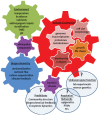Polar Microalgae: New Approaches towards Understanding Adaptations to an Extreme and Changing Environment
- PMID: 24833335
- PMCID: PMC4009763
- DOI: 10.3390/biology3010056
Polar Microalgae: New Approaches towards Understanding Adaptations to an Extreme and Changing Environment
Abstract
Polar Regions are unique and highly prolific ecosystems characterized by extreme environmental gradients. Photosynthetic autotrophs, the base of the food web, have had to adapt physiological mechanisms to maintain growth, reproduction and metabolic activity despite environmental conditions that would shut-down cellular processes in most organisms. High latitudes are characterized by temperatures below the freezing point, complete darkness in winter and continuous light and high UV in the summer. Additionally, sea-ice, an ecological niche exploited by microbes during the long winter seasons when the ocean and land freezes over, is characterized by large salinity fluctuations, limited gas exchange, and highly oxic conditions. The last decade has been an exciting period of insights into the molecular mechanisms behind adaptation of microalgae to the cryosphere facilitated by the advancement of new scientific tools, particularly "omics" techniques. We review recent insights derived from genomics, transcriptomics, and proteomics studies. Genes, proteins and pathways identified from these highly adaptable polar microbes have far-reaching biotechnological applications. Furthermore, they may provide insights into life outside this planet, as well as glimpses into the past. High latitude regions also have disproportionately large inputs into global biogeochemical cycles and are the region most sensitive to climate change.
Figures


Similar articles
-
It's what's inside that matters: physiological adaptations of high-latitude marine microalgae to environmental change.New Phytol. 2020 Sep;227(5):1307-1318. doi: 10.1111/nph.16648. Epub 2020 Jun 5. New Phytol. 2020. PMID: 32391569 Review.
-
Polar oceans in a changing climate.Curr Biol. 2017 Jun 5;27(11):R454-R460. doi: 10.1016/j.cub.2017.01.045. Curr Biol. 2017. PMID: 28586678
-
Wintertime Simulations Induce Changes in the Structure, Diversity and Function of Antarctic Sea Ice-Associated Microbial Communities.Microorganisms. 2022 Mar 15;10(3):623. doi: 10.3390/microorganisms10030623. Microorganisms. 2022. PMID: 35336197 Free PMC article.
-
The Minderoo-Monaco Commission on Plastics and Human Health.Ann Glob Health. 2023 Mar 21;89(1):23. doi: 10.5334/aogh.4056. eCollection 2023. Ann Glob Health. 2023. PMID: 36969097 Free PMC article. Review.
-
Comprehensive insights on environmental adaptation strategies in Antarctic bacteria and biotechnological applications of cold adapted molecules.Front Microbiol. 2023 Jun 16;14:1197797. doi: 10.3389/fmicb.2023.1197797. eCollection 2023. Front Microbiol. 2023. PMID: 37396361 Free PMC article. Review.
Cited by
-
Polar microalgae-based nanoparticles: a next-generation strategy for cancer treatment.3 Biotech. 2025 Jul;15(7):206. doi: 10.1007/s13205-025-04373-8. Epub 2025 Jun 11. 3 Biotech. 2025. PMID: 40521216
-
Physiological Effects and Mechanisms of Chlorella vulgaris as a Biostimulant on the Growth and Drought Tolerance of Arabidopsis thaliana.Plants (Basel). 2024 Oct 28;13(21):3012. doi: 10.3390/plants13213012. Plants (Basel). 2024. PMID: 39519931 Free PMC article.
-
Alanine to serine substitutions drive thermal adaptation in a psychrophilic diatom cytochrome c6.J Biol Inorg Chem. 2020 May;25(3):489-500. doi: 10.1007/s00775-020-01777-0. Epub 2020 Mar 27. J Biol Inorg Chem. 2020. PMID: 32219554
-
Polar microalgae extracts protect human HaCaT keratinocytes from damaging stimuli and ameliorate psoriatic skin inflammation in mice.Biol Res. 2023 Jul 13;56(1):40. doi: 10.1186/s40659-023-00454-1. Biol Res. 2023. PMID: 37438821 Free PMC article.
-
Ecophysiological and ultrastructural characterisation of the circumpolar orange snow alga Sanguina aurantia compared to the cosmopolitan red snow alga Sanguina nivaloides (Chlorophyta).Polar Biol. 2021;44(1):105-117. doi: 10.1007/s00300-020-02778-0. Epub 2020 Dec 11. Polar Biol. 2021. PMID: 33519055 Free PMC article.
References
-
- Smith W.O., Lancelot C. Bottom-up versus top-down control in phytoplankton of the Southern Ocean. Antarct. Sci. 2004;16:531–539. doi: 10.1017/S0954102004002305. - DOI
-
- Kirst G.O., Wiencke C. Ecophysiology of polar algae. J. Phycol. 1995;31:181–199.
-
- Mock T., Thomas D.N. Microalgae in Polar Regions: Linking Functional Genomics and Physiology with Environmental Conditions. In: Margesin R., Schinner F., Marx J.-C., Gerday C., editors. Psychrophiles: From Biodiversity to Biotechnology. Springer; Berlin/Heidelberg, Germany: 2008. pp. 285–312.
-
- Arrigo K.R., Mock T., Lizotte M.P. Primary production in sea ice. In: Thomas D., Dieckmann G., editors. Sea Ice: An Introduction to Its Physics, Chemistry, Biology and Geology. Wiley-Blackwell; Malden, MA, USA: 2010. pp. 143–183.
LinkOut - more resources
Full Text Sources
Other Literature Sources
Molecular Biology Databases
Miscellaneous

